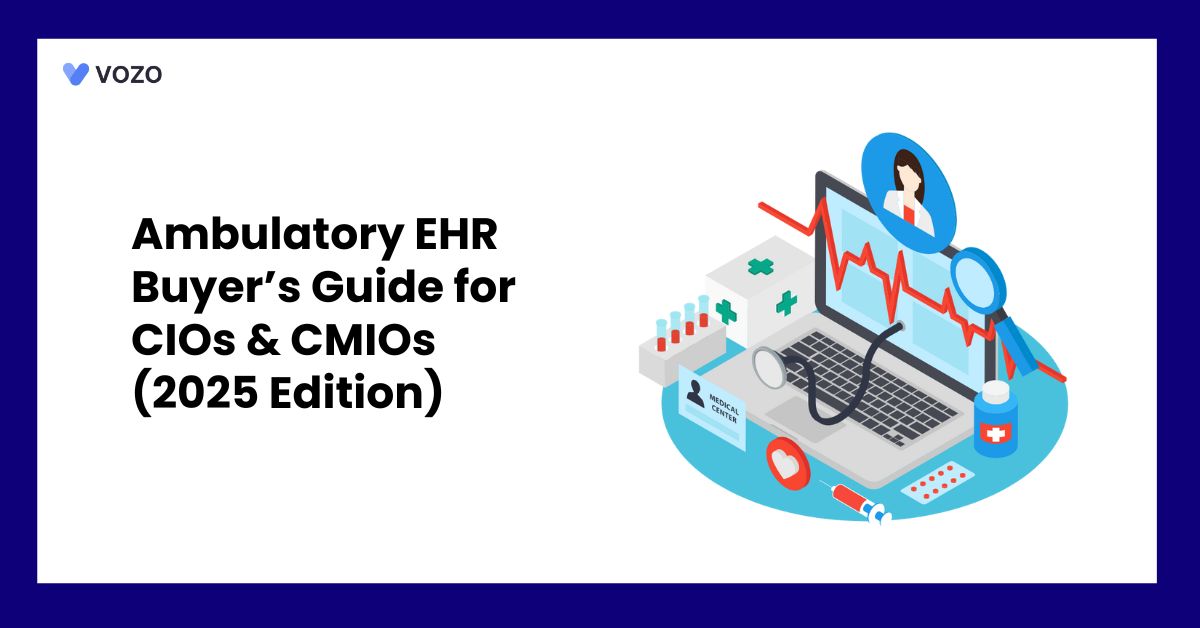Ambulatory EHR Buyer’s Guide for CIOs & CMIOs (2025 Edition)
Choosing the right EHR system for ambulatory care is more critical than ever in 2025. The U.S. ambulatory EHR market is expanding and projected to reach nearly $4 billion by 2031, with ~6% annual growth, driven by new payment models, patient expectations, and regulatory mandates.
With many vendors and evolving requirements, CIOs and CMIOs must carefully evaluate ambulatory EHR options to find a fit for their clinical workflows, specialty needs, and strategic goals.
This blog outlines the latest trends, must-have features, leading vendors, and a decision framework to help buyers navigate the 2025 ambulatory EHR landscape.
Key Trends and Challenges in Ambulatory Care
Ambulatory care is undergoing major transformations that shape EHR requirements. Providers are expected to track quality metrics and manage patient populations proactively. In practice, this means EHRs must support quality reporting, risk stratification, and performance dashboards to help clinicians improve care and reduce costs.
1. Value-Based Care & Population Health
Providers need EHR tools for quality metrics, reporting, and patient registries. The move to value-based models and patient-driven healthcare has “fueled” demand for interoperable, analytics-capable EHRs.
2. Interoperability & Regulations
Federal mandates require open APIs and data sharing. EHRs must be certified and prepared to connect to nationwide networks.
3. AI and Advanced Analytics
Built-in AI for charting, billing, and population health forecasting is on the rise. Surveys show nearly all specialists want AI/ML capabilities in their next EHR.
4. Patient Engagement & Telehealth
EHRs now must include robust patient portals, mobile apps, and video visit integration. For example, portals will offer secure record access, reminders, chatbots, and scheduling, all aimed at boosting patient involvement and outcomes
5. Security & Privacy
Strengthened data protections, such as encryption, MFA, and audit logs, are non-negotiable. Next-generation EHRs emphasize HIPAA compliance through features like biometric login and dynamic consent workflows.
Related: Key Features of Ambulatory Care EHR to Elevate Outpatient Care
Key EHR Features and Capabilities to Prioritize
When evaluating ambulatory EHRs, CIOs and CMIOs should focus on capabilities that address the above trends and fit their practice’s needs.
1. Usability & Customization
Look for intuitive, clinician-friendly interfaces and the ability to tailor workflows. Ambulatory practices often have varied documentation needs by specialty; EHRs with customizable templates or specialty modules can improve efficiency. The EHR should minimize clicks and streamline tasks (e.g., easily update a prescription or lab order).
2. Telehealth Integration
The chosen EHR should natively support video visits and virtual care documentation. Ideally, the system’s scheduling, billing, and charting will encompass telehealth encounters with minimal extra steps. The COVID-19 era established telehealth as mainstream by 2025, and integrated virtual care is a core requirement.
3. Mobile Access & Remote Use
Modern ambulatory workflows demand mobility. EHRs should have responsive web/mobile apps or dedicated smartphone/tablet clients so clinicians can review records, e-prescribe, and document from anywhere.
Cloud-based platforms with on-device capabilities, such as built-in speech-to-text, allow instantaneous access to data, boosting productivity.
4. Interoperability & APIs
Ensure the EHR meets the latest ONC certification criteria (including FHIR APIs and USCDI compliance). It should readily exchange CCDs or FHIR data with other systems (labs, imaging, hospitals, HIEs).
Support for Direct Messaging, ELR feeds, and social determinants data can be important for integrated care. Given TEFCA’s implementation, verifying a plan for connectivity or QHIN participation is wise.
5. Revenue Cycle Management
Although technically not always part of the “core EHR,” the ability to handle billing, coding, and claims or seamlessly integrate with a robust PM/RCM system is crucial. Many ambulatory vendors bundle Ensure the EHR supports HL7/C-CDA exchange with your billing system.
6. Security & Compliance
Look for enterprise-grade security: audit trails, encryption of data at rest and in transit, role-based access, and support for multi-factor login. The EHR must be HIPAA-compliant and, in many cases, ONC-certified for the latest criteria.
Features like automatic timeout, granular audit logs, and data loss prevention help meet regulations. Inquire about vendor policies on data ownership, breach notification, and business associate agreements.
Related: EHR Adoption in Ambulatory Care: Benefits, Challenges, and Best Practices
Implementation and Scalability Considerations
Choosing an EHR is only half the battle – successful implementation and future scalability are equally important. CIOs should assess how each vendor supports the implementation and growth of their system.
Deployment Model
Many ambulatory EHRs now offer cloud-based (SaaS) versions. Cloud platforms can simplify scalability and updates: they provide secure remote access for distributed clinics and reduce the need for on-premises IT infrastructure.
Industry research notes the EHR market is rapidly “transitioning from server-based to cloud-based” systems. Cloud EHRs offer scalability, cost-efficiency, and easier data sharing across sites, making them a preferred choice for both small practices and large networks.
Integration with Existing Systems
The new ambulatory EHR must integrate smoothly with your organization’s current technologies – including lab systems, imaging/PACS, pharmacy records, revenue cycle (billing) systems, and HR/payroll. Confirm that the vendor has experience with your specific systems or common third-party interfaces.
Training and Change Management
Adequate training resources are vital. Ensure the vendor provides comprehensive training programs (online/on-site) tailored to ambulatory workflows. Some practices set up “training trackers” or clinical champions to guide staff. During vendor demos, probe how easily end-users such as physicians, nurses, and front-office staff adapt to the software..
Scalability and Multi-Clinic Growth
Even if starting small, plan for growth more providers, additional locations, or affiliations. The EHR should be able to handle an expanding number of users and patient records without performance degradation.
Multi-site management tools like centralized dashboards, cross-site reporting. They are valuable for growing practices. Clarify whether licensing or fees change significantly with new providers or clinics.
Compliance and Certification Standards
Ambulatory EHRs must meet several regulatory requirements. First and foremost, the software should be ONC Health IT Certified. While certification is technically voluntary, any practice seeking federal incentives MIPS/PI, Medicaid Promoting Interoperability, etc., must use a certified EHR. The vendor should provide documentation of certification.
HIPAA compliance is mandatory. Verify the EHR vendor’s HIPAA security rule compliance by asking about encryption standards, breach history, and business associate agreements. Certification does not guarantee HIPAA safety, so review how the system handles access controls and audit trails. The EHR should also comply with any state laws or CMS rules relevant to ambulatory practices.
The new TEFCA network is also directly relevant, and this federal Trusted Exchange Framework, mandated by the Cures Act, aims to create a universal data-sharing infrastructure. By 2025, many major EHR vendors will have TEFCA connectivity options, such as Epic’s Epic Nexus or certified QHIN access.
Related: From Fax to API: Why EHR Buyers Are Prioritizing Interoperability First
Evaluation Process and Buyer’s Checklist
With trends, features, and standards in mind, CIOs and CMIOs should follow a structured evaluation process. Engage stakeholders such as clinicians, nurses, admin staff, billing, and IT early to gather requirements. Use the input to draft an RFI or RFP outlining needed capabilities, referring to the key features above and evaluation criteria. Key checklist items include:
- Define Stakeholder Needs – Interview clinical and administrative users to document current pain points and “must-have” features. Prioritize requirements by specialty and user role.
- Develop a Budget and ROI Analysis – Estimate total cost of ownership, such as licensing, hardware, implementation, training, and maintenance. Compare this to expected benefits like efficiency gains, better revenue capture, etc., to justify the investment.
- Research & Shortlist Vendors – Use KLAS reports, peer references, and industry resources to create a shortlist of 3–5 vendors that fit the requirements. Consider vendor market presence like big companies vs. specialty ones, based on your practice type.
- Issue RFI/RFP – Send a detailed Request for Information/Proposal to shortlisted vendors, requesting specifics on functionality, interfaces, support, and pricing. Use uniform questions to compare responses.
- Demonstrations and Scoring – Arrange product demos with each vendor, focused on your high-priority workflows. Have key users attend. Create a scoring rubric to objectively rate each demo.
- Reference Checks – Contact existing customers of the vendor, ideally similar-sized organizations, to ask about satisfaction, support experiences, and any hidden issues.
- Site Visits and Pilots – If possible, visit a site using the EHR. Observe real-world usage. Some organizations also conduct limited pilot implementations (e.g., with one department or clinic) to test the system in their environment before full rollout.
- Decision Framework – Compile all evaluation data, such as demo scores, financial analysis, reference feedback, and compare vendors. Use a weighted scoring model if helpful, giving extra weight to critical factors (e.g., patient safety features or specialty modules).
- Negotiations and Contract – Once a preferred vendor is chosen, negotiate favorable contract terms: service levels, price protection, data access/portability clauses, and exit options. Involve legal and procurement teams to review any fine print.
- Implementation Planning – Before go-live, ensure a robust project plan. Define roles (vendor project manager, internal champions, IT lead), timelines, and training strategies. Establish metrics for “go/no-go” at each phase.
Vozo EHR for your Ambulatory Care Practice
Small healthcare practices like Ambulatory care require a more streamlined process and workflow. The EHR solution will help you to digitize the workflow and streamline the process.
Whether you are looking for a reliable EHR system to implement or decide to switch from your old legacy EHR, Vozo is here to help you.
We are professional experts with years of experience in the field, providing quality service for our clients.
Vozo’s EHR system offers a vast range of benefits for the Ambulatory care practice.
- Streamline the Ambulatory care workflow and speed up the process
- Easy transition from paper workflow to digital workflow
- Provides complete access to patients’ up-to-date medical records
- Accurate reports and analytics
- Our EHR system continues to scale as your healthcare practice grows
- 24/7 Tech support to assist you with any needs and requirements
Our EHR system allows you to manage all the patients’ records under one roof, reducing the heavy workload for your healthcare practice staff.
Trust in Vozo EHR as we reduce your burdens and let you focus more on better patient outcomes.
About the author

With more than 4 years of experience in the dynamic healthcare technology landscape, Sid specializes in crafting compelling content on topics including EHR/EMR, patient portals, healthcare automation, remote patient monitoring, and health information exchange. His expertise lies in translating cutting-edge innovations and intricate topics into engaging narratives that resonate with diverse audiences.













